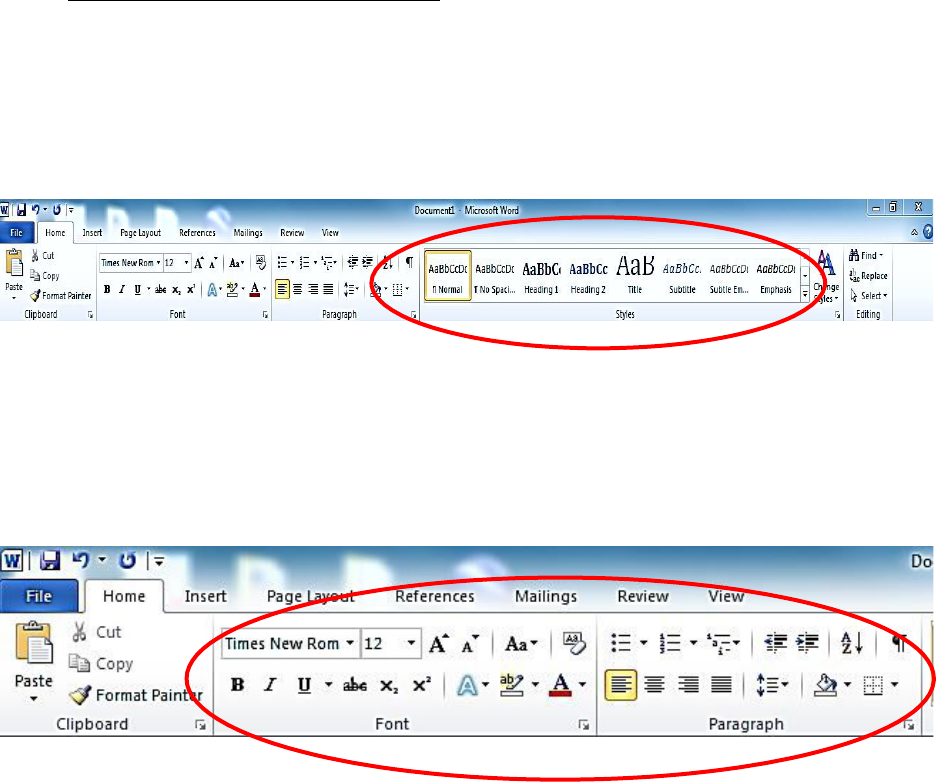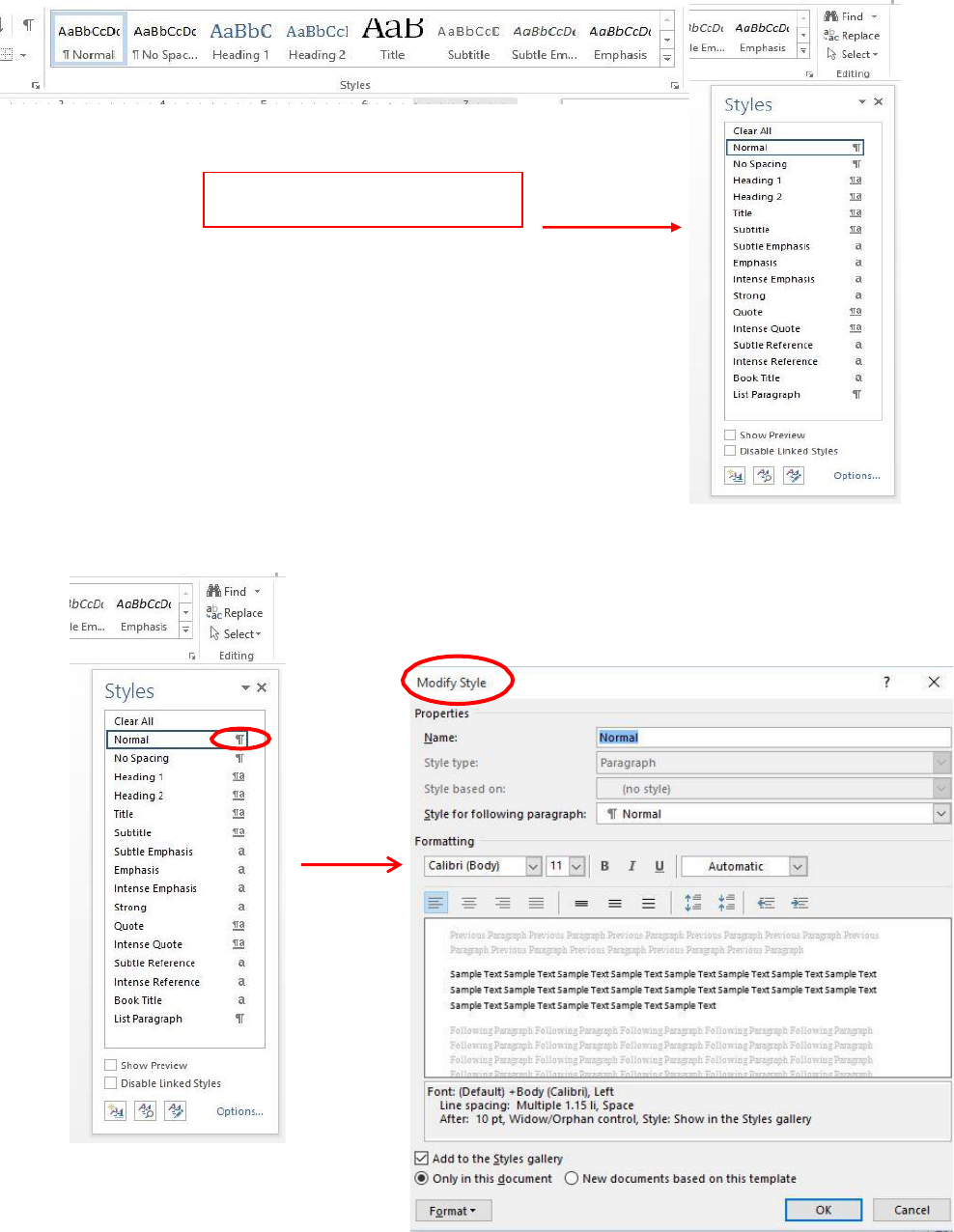
Updated: by GC SST Summer 2021
Manual for Formatting Requirements for Font Size, Style, and Type
and Spacing: Changing the Default Paragraph Styles
1
This manual first provides information on:
1. The specific format requirements for font size, style, and type and spacing.
2. It provides step-by-step instructions on how to change the default paragraph style
settings to match these requirements for your entire document.
This ensures that the font style and size and paragraph spacing remain consistent in your
electronic thesis/ dissertation.
Sections:
Section 1: Format Requirements for Font Size, Style, and Type and Spacing (p. 1)
Section 2: Paragraph Style: The Default Style and How to Change It (pp. 2-4)
1
Information for this manual has been modified from: University of Central Florida College of Graduate Studies.
(2012). Step 2: Headings and Subheadings. Retrieved from
file:///C:/Users/dibened2/Downloads/Headings%20and%20Subheadings_Word%202007%20(2).pdf.

Updated: by GC SST Summer 2021
1
Section 1: Format Requirements for Font Size, Style, and Type and Spacing
Font size, style, and type:
o The font must be a standard style that is clear and readable. Script, cursive, and
pictorial fonts are prohibited.
o All document text with the exception of items embedded in figures must be black.
o Font size should be 11 or 12 point.
o Italicized fonts are only accepted where allowed or required by your chosen style
guide (Chicago, APA, ASA, MLA, etc.)
o Font size and font type must be consistent throughout the text.
o Chapter titles and sections can be a larger font size than the standard text, if in
accordance with the student’s approved style guide and advisory committee. This
style decision must be applied consistently throughout the text.
o The font size of tables and figures can be smaller than the standard text if in
accordance with the student’s style guide and advisory committee. This style decision
must be applied consistently throughout the text. Font cannot be at less than 8 point
to allow for readability.
Spacing:
o The document must be double spaced.
o The only exceptions are: captions; foot-notes; long quotations; bibliographic
references; table titles and descriptions; figure titles and descriptions;
inserted materials such as tables, images, diagrams, graphs, etc.; and the
author’s curriculum vitae.
o Extended direct quotations must be handled according to the rules of your chosen
style guide and the direction of your advisory committee.
o Paragraphs should be indented the same number of spaces throughout the document,
and spacing between paragraphs should be consistent.
o Spacing around titles, headings, and subheadings should be consistent and match
the student’s chosen style guide.

Updated: by GC SST Summer 2021
2
Section 2: Paragraph Style: The Default Style and How to Change It
The Default Style or The Normal Style:
The default setting for a new, blank Microsoft Word document (2007 or newer) is called the
Normal Style. This means that when you open a new document, a default font style (Calibri),
line spacing (1.15 spaces with an additional 10 points after each line), and font size (11
points) are already in place. The Normal style is highlighted in yellow in the Styles pane
located at the top of your document in the Home tab.
These settings are automatically applied to the entire document unless you manually change
them.
In order to apply a different paragraph style, individuals generally go to the Font and Paragraph
tool bars in the Home tab (illustrated below). This allows people to change their font styles and
line spacing, amongst other visual attributes.
However, there is another approach that is more advisable for electronic thesis and
dissertation formatting. Instead of going to the Font and Paragraph tool bars, it is better to
change the default template rather than just making changes to the body text only. Changing
the Normal Style will ensure that the font style and size and paragraph spacing are consistent
throughout your document. This prevents Word from reverting back to the default style at
certain times, which may result in inconsistencies that you mostly want to avoid.

Updated: by GC SST Summer 2021
3
First, you want to make sure that the Normal Style is applied to the body text of your thesis/
dissertation. If you have already manually changed the font style and size and paragraph spacing
using the Font and Paragraph tool bars, there is no reason to delete your work! You will want to
make sure that the Normal Style matches whatever font style and size and paragraph spacing you
have put in place. Remember the Graduate College has a few policies on this that must be
followed:
• The document must be double spaced.
o Remember the exceptions are: captions, footnotes, long quotations,
bibliographic references, table titles and descriptions, figure titles and
descriptions, inserted materials such as tables, images, diagrams, graphs, etc.,
and the author’s curriculum vitae
• There is not a preferred font style; however, you can only use one style type (i.e.,
Times New Roman, Arial, Calibri, etc.).
• The font size must be either 11 point or 12 point size. Similarly, one size must be used for
your body text. However, you may have a smaller font size (no smaller than 8 point size)
for the title and descriptions of tables, figures, and other inserted items in your
document. The font used on your title page and copyright page should be the same size
and font used in the main body of your document it should not be bolded.
Modifying the Normal Style:
Located at the lower, right-hand corner of the Style section (in the Home’s tab) is a little
diagonal arrow. To display the Styles menu, you must click on this arrow. You can also hit
Alt+Ctrl+Shift+S.

Updated: by GC SST Summer 2021
4
1. In the Styles box, find Normal. Click the arrow (paragraph scroll) located to the right of the
word (Do not click the word ‘Normal’).
The Styles menu should
look similar to this
Updated: by GC SST Summer 2021
5
2. This will bring up a drop down menu. select Modify. This will bring up menu called Modify Style.
3. This menu has all of the same features usually found on your toolbar. However, it is where
you can change the default settings for your font size and font type, spacing, and more. If
you need additional options, you can chose the format button located at the bottom left of
the menu box. Remember:
a. The document must be double-spaced
b. There is not a required standard font size or style; however, they must be
consistent throughout the document.
